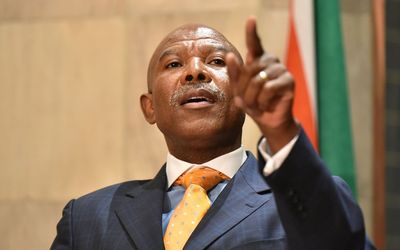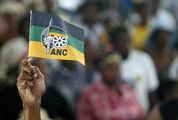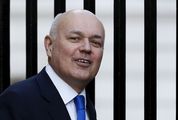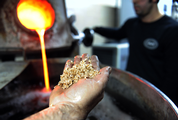IT IS hard not to wonder whether the events of the past few days were the factor that tipped the monetary policy committee into opting for a 25-basis point hike rather than a hold. And rightly so. This is not the time to take any chances with either policy credibility or the exchange rate. But the battle lines that have been drawn between Finance Minister Pravin Gordhan and the Hawks, and the dramatic disclosures of the Gupta family’s influence on ministerial appointments have undermined SA’s credibility with investors further and put new downward pressures on the rand.
What seemed a high-risk and volatile environment at the start of the monetary policy committee’s meeting on Tuesday was even more so by on Thursday, and if the committee’s response was on the hawkish side (in the monetary policy sense), it cannot be faulted for acting to manage the risks as best as it can. However, the decision to hike was clearly a tough and a contested one, with half of the committee’s members starting out in favour of keeping rates on hold rather than implementing another increase after the 50-basis point hike in January.
It is quite unusual for the central bank to hike rates when it has just reduced its inflation forecast — as the bank has done, with inflation for this year now expected to average 6.6%, down from January’s 6.8% estimate and the forecast for next year cut from 7% to 6.4%. Even so, the bank remains extremely worried about the length of time over which inflation will still be in breach of the target range — it is due to come back down to less than 6% only in the fourth quarter of next year.
The committee also made much, again, of the fact that inflationary expectations are stuck at or above the top of the target range — five-year expectations average 6.1%.
As long as expectations are anchored around 6%, chances are that pricing behaviour and wage demands will reflect that assumption, making it difficult to get inflation down, with the risk that a big shock to the system, such as an exchange rate crash or a spike in food prices, prompts an inflationary spiral.
Food-price inflation is a serious concern for the committee, as it should be to all of us, especially given how big a chunk of poor households’ spending goes on food.
The committee said food-price pressures had intensified, driven by the drought and the depreciated exchange rate, and with agricultural prices having increased almost 26% at producer-price level, food inflation for consumers is now expected to jump to a peak of 11.6% in the last quarter of this year.
Transport prices are an issue too, even though global oil prices have fallen, because the weak rand drives up fuel prices, as will the extra 30c a litre on the fuel levy that was announced in the budget. Since the January meeting, the rand exchange rate has actually improved somewhat, gaining 4.5% against the dollar. But the committee emphasised how volatile and vulnerable it is to domestic and international developments — including the risk of a sovereign ratings downgrade — and, of course, the risk to the rand, and indeed to the country, posed by the events of recent days.
An increasingly weak economy and beleaguered consumers are hardly going to be helped by yet another interest rate hike and the prospect is a rather miserable one. As it is, the bank has cut its growth forecast again, although at 0.8%, it isn’t even among the more pessimistic of forecasters. There is not a lot monetary policy can do, though, to boost growth, and its price-stability mandate may be more important than ever under current circumstances.
Governor Lesetja Kganyago took the trouble on Thursday to spell out just how vulnerable poor households and those on fixed incomes, such as pensioners, are to the effect of inflation. In the difficult task of balancing growth and inflation, that surely has to be a factor.

Lesetja Kganyago. Picture: TREVOR SAMSON
IT IS hard not to wonder whether the events of the past few days were the factor that tipped the monetary policy committee into opting for a 25-basis point hike rather than a hold. And rightly so. This is not the time to take any chances with either policy credibility or the exchange rate. But the battle lines that have been drawn between Finance Minister Pravin Gordhan and the Hawks, and the dramatic disclosures of the Gupta family’s influence on ministerial appointments have undermined SA’s credibility with investors further and put new downward pressures on the rand.
What seemed a high-risk and volatile environment at the start of the monetary policy committee’s meeting on Tuesday was even more so by on Thursday, and if the committee’s response was on the hawkish side (in the monetary policy sense), it cannot be faulted for acting to manage the risks as best as it can. However, the decision to hike was clearly a tough and a contested one, with half of the committee’s members starting out in favour of keeping rates on hold rather than implementing another increase after the 50-basis point hike in January.
It is quite unusual for the central bank to hike rates when it has just reduced its inflation forecast — as the bank has done, with inflation for this year now expected to average 6.6%, down from January’s 6.8% estimate and the forecast for next year cut from 7% to 6.4%. Even so, the bank remains extremely worried about the length of time over which inflation will still be in breach of the target range — it is due to come back down to less than 6% only in the fourth quarter of next year.
The committee also made much, again, of the fact that inflationary expectations are stuck at or above the top of the target range — five-year expectations average 6.1%.
As long as expectations are anchored around 6%, chances are that pricing behaviour and wage demands will reflect that assumption, making it difficult to get inflation down, with the risk that a big shock to the system, such as an exchange rate crash or a spike in food prices, prompts an inflationary spiral.
Food-price inflation is a serious concern for the committee, as it should be to all of us, especially given how big a chunk of poor households’ spending goes on food.
The committee said food-price pressures had intensified, driven by the drought and the depreciated exchange rate, and with agricultural prices having increased almost 26% at producer-price level, food inflation for consumers is now expected to jump to a peak of 11.6% in the last quarter of this year.
Transport prices are an issue too, even though global oil prices have fallen, because the weak rand drives up fuel prices, as will the extra 30c a litre on the fuel levy that was announced in the budget. Since the January meeting, the rand exchange rate has actually improved somewhat, gaining 4.5% against the dollar. But the committee emphasised how volatile and vulnerable it is to domestic and international developments — including the risk of a sovereign ratings downgrade — and, of course, the risk to the rand, and indeed to the country, posed by the events of recent days.
An increasingly weak economy and beleaguered consumers are hardly going to be helped by yet another interest rate hike and the prospect is a rather miserable one. As it is, the bank has cut its growth forecast again, although at 0.8%, it isn’t even among the more pessimistic of forecasters. There is not a lot monetary policy can do, though, to boost growth, and its price-stability mandate may be more important than ever under current circumstances.
Governor Lesetja Kganyago took the trouble on Thursday to spell out just how vulnerable poor households and those on fixed incomes, such as pensioners, are to the effect of inflation. In the difficult task of balancing growth and inflation, that surely has to be a factor.





















Change: 1.19%
Change: 1.36%
Change: 2.19%
Change: 1.49%
Change: -0.77%
Data supplied by Profile Data
Change: -0.19%
Change: 0.69%
Change: 1.19%
Change: 0.00%
Change: 0.44%
Data supplied by Profile Data
Change: 0.62%
Change: 0.61%
Change: 0.23%
Change: 0.52%
Change: 0.12%
Data supplied by Profile Data
Change: -0.21%
Change: -1.22%
Change: -0.69%
Change: -0.51%
Change: 0.07%
Data supplied by Profile Data